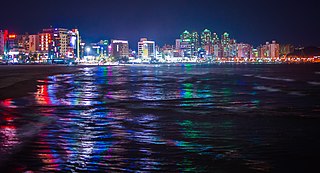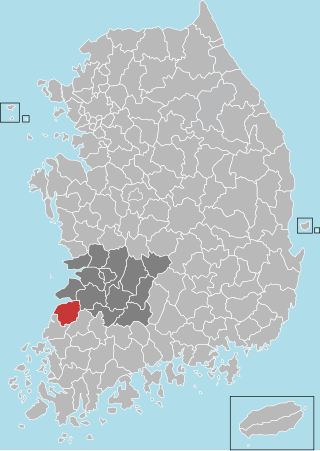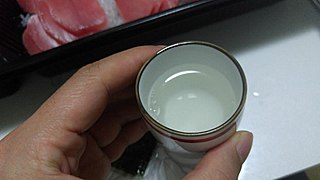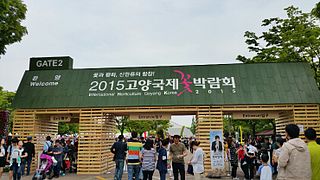Related Research Articles

Pohang is the largest city in North Gyeongsang Province, South Korea, with a population of 499,363 as of 2022, bordering the East Sea to the east, Yeongcheon to the west, Gyeongju to the south, and Cheongsong and Yeongdeok to the north.

Cheongju is the capital and largest city of North Chungcheong Province in South Korea.

Gochang County (Gochang-gun) is a county in North Jeolla Province, South Korea. It is a rural area, and is home to only one institution of higher education: Gochang Polytechnic College.

Cheonan is the largest and most densely populated city of Chungcheongnam-do, South Korea, and the third largest city in the Hoseo region after Daejeon and Cheongju. Cheonan borders Gyeonggi-do in the north, Chungcheongbuk-do to the east and southeast, Sejong City to the south and Asan-si and Gongju-si to the west and southwest.

Makgeolli, sometimes anglicized to makkoli, is a Korean alcoholic beverage. The milky, off-white, and lightly sparkling rice wine has a slight viscosity that tastes slightly sweet, tangy, bitter, and astringent. Chalky sediment gives it a cloudy appearance. As a low proof drink of six to nine percent alcohol by volume, it is often considered a "communal beverage" rather than hard liquor. In Korea, makgeolli is often unpasteurized, and the wine continues to mature in the bottle. Because of the short shelf life of unpasteurized "draft" makgeolli, many exported makgeolli undergo pasteurization, which deprives the beverage of complex enzymes and flavor compounds. Recently, various fruits such as strawberries and bananas are added to makgeolli to drink in new forms.

Daeboreum is a Korean holiday that celebrates the first full moon of the new year of the lunar Korean calendar which is mostly based on the lunisolar Chinese calendar. The festival is Korean version of the First Full Moon Festival. This holiday is accompanied by many traditions.

Tourism in South Korea refers to the tourist industry in the Republic of Korea. In 2012, 11.1 million foreign tourists visited South Korea, making it the 20th most visited country in the world, and the 5th most visited in Asia. Most non-Korean tourists come from other parts of East Asia such as Japan, China, Taiwan, and Hong Kong. The recent popularity of Korean popular culture, often known as the "Korean Wave", in these countries has increased tourist arrivals. Seoul is the principal tourist destination for visitors; popular tourist destinations outside of Seoul include the major coastal city of Busan, the Seorak-san national park, the historic city of Gyeongju and subtropical Jeju Island. Traveling to North Korea is not normally possible without a special permission.

Cheongju, sometimes romanized as Chungju, is a clear, refined rice wine of Korean origin.

Jokbal(족발) is a Korean dish consisting of pig's trotters cooked with soy sauce and spices. It is usually braised in a combination of soy sauce, ginger, garlic, and rice wine. Additional ingredients used can include onion, leeks, garlic, cinnamon, and black pepper.

Seongdong market is the largest traditional market in Gyeongju, North Gyeongsang province, South Korea. Located on the opposite side of Gyeongju station with an entrance on Wonhwa-ro (street), it provides crops, vegetables, fruits, and seafood produced in Gyeongju and nearby areas. There are also vendors that sell street food such as kimbap, sundae, and tteokbokki. An indoor area composed of ten or so restaurants offer fresh banchan as a buffet-style meal or à la carte. Seongdong Market was established in 1971. The market opens in the early morning.

The Ansan Street Arts Festival is an annual street festival held every May in the city of Ansan, South Korea.
Sinjeong Market is a traditional street market in Nam-gu, Ulsan, South Korea. Established in 1970, today the market has more than 700 shops that sell fruits, vegetables, meat, fish, breads, clothing, and Korean traditional medicinal items. The market is also home to many small restaurants and street food stalls.
Itaewon Global Village Festival is an annual cultural festival held in Itaewon, South Korea, since 2002. It is hosted by the Itaewon Tourism Zone Association and takes place in the fall, typically in October. The main objective of the festival is to heat up tourism in the Itaewon area, as well as attract foreign visitors.

Gwangjang Market (Korean: 광장시장), previously Dongdaemun Market (동대문시장), is a traditional street market in Jongno-gu, Seoul, South Korea. The market is one of the oldest and largest traditional markets in South Korea, with more than 5000 shops and 20,000 employees in an area of 42,000 m2 (450,000 sq ft). Approximately 65,000 people visit the market each day.

The Goyang International Flower Festival is one of the largest flower festivals in South Korea and takes place in the city of Goyang. It attracts many visitors annually. The festival is held in a metropolitan area and serves as a model for local culture festivals, in which some foreign flower farmers participate.

Baekje Cultural Land (Korean: 백제문화단지) is a Korean historical theme park located in Buyeo County in South Chungcheong province, South Korea. It is the largest historical theme park in the country, built to preserve the history and culture of the Baekje kingdom. The theme park is one of the locations of the annual Baekje Cultural Festival. The location has been used for filming sageuk films and television series, for example Moon Lovers: Scarlet Heart Ryeo was partially shot here, as well as an episode of Running Man.
Newtro (Hangul:뉴트로) is a portmanteau of the words "new" and "retro", and refers to the trend of "modernized retro". Newtro's beginnings can be traced back to 2018 in South Korea.
The Food Festivals of South Korea are a series of celebrations that provide insight into Korea's cuisine and culture. The cuisine ranges from traditional dishes through to modern interpretations and will often focus on regionally specific recipes and ingredients. They seek to retain Korean cultural identity, raise awareness, and promote local produce, cuisine, and the Korean food industry. Over time, some festivals and dishes such as Chimaek have become part of modern Korean culture and were further popularized by K-dramas.
References
- ↑ "Yukgeori market-Life Culture and Sightseeing City, Cheongju".
- 1 2 3 4 "전국 5대 재래시장, 청주 육거리종합시장<일상의 공간들, 우리 마을이야기<지역N문화 테마". Ncms.nculture.org. Retrieved 2022-05-05.
- 1 2 "Visitkoreanmarket".
- ↑ "Artistic makeover for ancient Korean bridge". Travel Daily. 1 June 2017.
- ↑ "Dancing Musimcheondo, Cheongju Yukgeori Market – Cheongju, Chungbuk, Korea". codecorea.github.io. 25 March 2020.
- ↑ Jeong, Sang Kyu; Ban, Yong Un (January 2020). "Spatial Configurations for The Revitalization of a Traditional Market: The Case of Yukgeori Market in Cheongju, South Korea". Sustainability. 12 (7): 2937. doi: 10.3390/su12072937 .
- ↑ "재래시장 '온누리 상품권' 10% 할인판매 인기". 24 January 2019.
- ↑ ""청주 육거리시장·성안길에서 봄 축제 즐기세요"". 26 April 2017.
- ↑ "육거리종합시장, '코로나19 종식 염원 행사' 개최". 14 June 2021.
- ↑ "KTO Releases List of 16 Traditional Markets for Tourists". 15 May 2015.
- ↑ "중소벤처기업부".